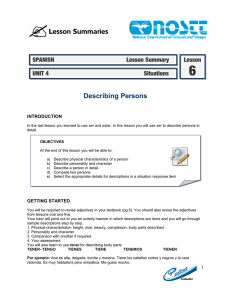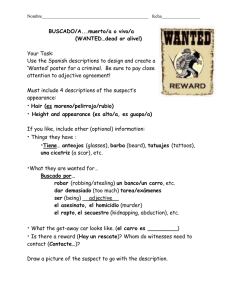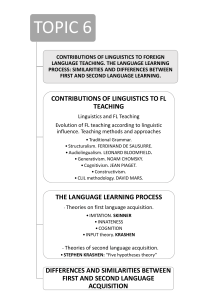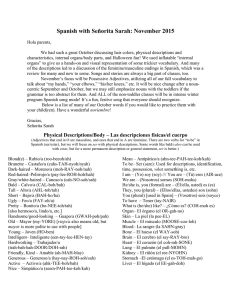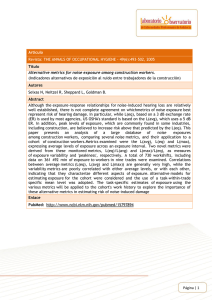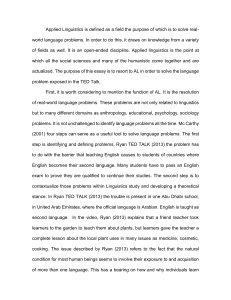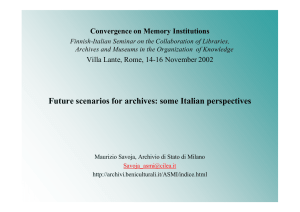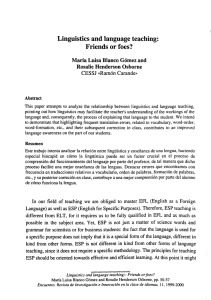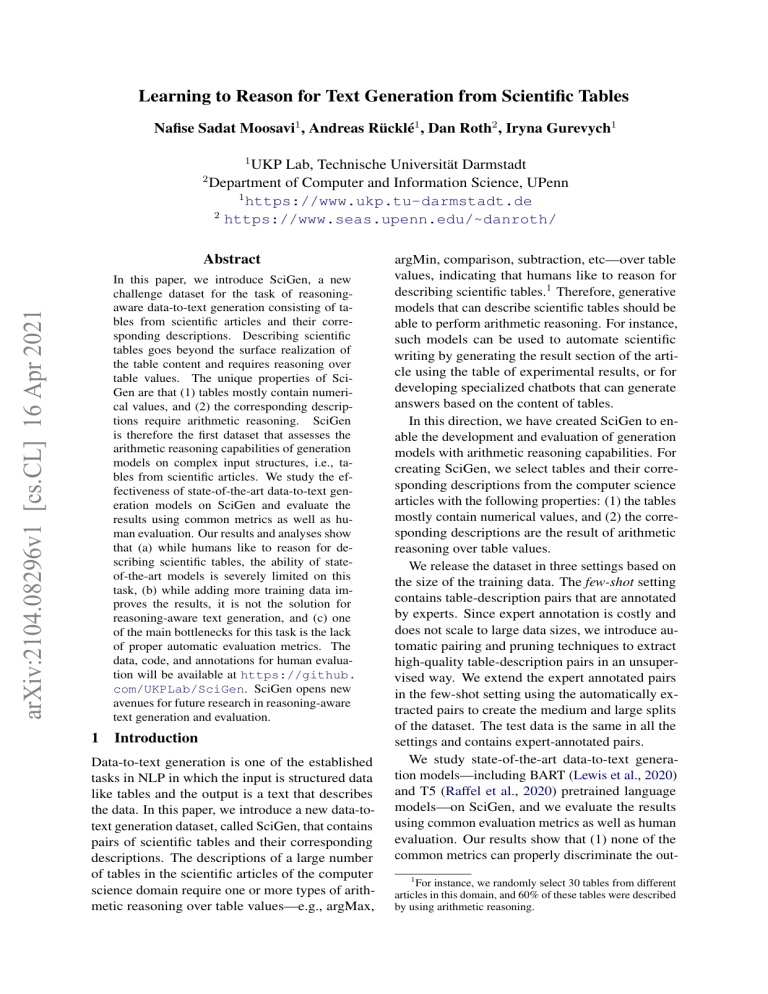
Learning to Reason for Text Generation from Scientific Tables
Nafise Sadat Moosavi1 , Andreas Rücklé1 , Dan Roth2 , Iryna Gurevych1
1
2
UKP Lab, Technische Universität Darmstadt
Department of Computer and Information Science, UPenn
1
https://www.ukp.tu-darmstadt.de
2
https://www.seas.upenn.edu/~danroth/
Abstract
arXiv:2104.08296v1 [cs.CL] 16 Apr 2021
In this paper, we introduce SciGen, a new
challenge dataset for the task of reasoningaware data-to-text generation consisting of tables from scientific articles and their corresponding descriptions. Describing scientific
tables goes beyond the surface realization of
the table content and requires reasoning over
table values. The unique properties of SciGen are that (1) tables mostly contain numerical values, and (2) the corresponding descriptions require arithmetic reasoning. SciGen
is therefore the first dataset that assesses the
arithmetic reasoning capabilities of generation
models on complex input structures, i.e., tables from scientific articles. We study the effectiveness of state-of-the-art data-to-text generation models on SciGen and evaluate the
results using common metrics as well as human evaluation. Our results and analyses show
that (a) while humans like to reason for describing scientific tables, the ability of stateof-the-art models is severely limited on this
task, (b) while adding more training data improves the results, it is not the solution for
reasoning-aware text generation, and (c) one
of the main bottlenecks for this task is the lack
of proper automatic evaluation metrics. The
data, code, and annotations for human evaluation will be available at https://github.
com/UKPLab/SciGen. SciGen opens new
avenues for future research in reasoning-aware
text generation and evaluation.
1
Introduction
Data-to-text generation is one of the established
tasks in NLP in which the input is structured data
like tables and the output is a text that describes
the data. In this paper, we introduce a new data-totext generation dataset, called SciGen, that contains
pairs of scientific tables and their corresponding
descriptions. The descriptions of a large number
of tables in the scientific articles of the computer
science domain require one or more types of arithmetic reasoning over table values—e.g., argMax,
argMin, comparison, subtraction, etc—over table
values, indicating that humans like to reason for
describing scientific tables.1 Therefore, generative
models that can describe scientific tables should be
able to perform arithmetic reasoning. For instance,
such models can be used to automate scientific
writing by generating the result section of the article using the table of experimental results, or for
developing specialized chatbots that can generate
answers based on the content of tables.
In this direction, we have created SciGen to enable the development and evaluation of generation
models with arithmetic reasoning capabilities. For
creating SciGen, we select tables and their corresponding descriptions from the computer science
articles with the following properties: (1) the tables
mostly contain numerical values, and (2) the corresponding descriptions are the result of arithmetic
reasoning over table values.
We release the dataset in three settings based on
the size of the training data. The few-shot setting
contains table-description pairs that are annotated
by experts. Since expert annotation is costly and
does not scale to large data sizes, we introduce automatic pairing and pruning techniques to extract
high-quality table-description pairs in an unsupervised way. We extend the expert annotated pairs
in the few-shot setting using the automatically extracted pairs to create the medium and large splits
of the dataset. The test data is the same in all the
settings and contains expert-annotated pairs.
We study state-of-the-art data-to-text generation models—including BART (Lewis et al., 2020)
and T5 (Raffel et al., 2020) pretrained language
models—on SciGen, and we evaluate the results
using common evaluation metrics as well as human
evaluation. Our results show that (1) none of the
common metrics can properly discriminate the out1
For instance, we randomly select 30 tables from different
articles in this domain, and 60% of these tables were described
by using arithmetic reasoning.
puts of reasoning-aware text generation, and the
lack of a proper automatic evaluation metric is the
main bottleneck for the progress for this task, (2)
while the generated outputs by the examined models are coherent and fluent and look like valid descriptions, they are mostly factually incorrect given
the content of the table, i.e., the entities that appear in the description are relevant to the table but
the lack arithmetic reasoning capabilities results
in incorrect statements about the present results
in the table, and (3) the addition of automatically
extracted training data in the medium and large settings reduces the hallucination and improves the
correctness of the generated descriptions, however,
the extent that they can improve the correctness is
limited, e.g., the correctness of the outputs in the
large setting is lower than those in medium.
Overall, the main contributions of this paper are:
• We release SciGen, the first reasoning-aware
data-to-text generation dataset based on scientific articles.
• We provide our code for extracting tabledescription pairs from latex files of scientific
articles that (1) provides high-quality unsupervised training data, and (2) facilitates future
annotation studies for new domains.
• We provide all the data and annotations that
is used for our human evaluations to help the
creation of new metrics for this task as our results suggests that existing automatic metrics
are not discriminative for this task.
• We show that text generation using arithmetic
reasoning is a challenging task that cannot be
solved by merely adding more data or applying large pre-trained models.
2
Related Work
The task of data-to-text generation is to generate coherent, relevant, and meaningful natural language
text that describes the non-linguistic input data like
tables, knowledge bases, tuples, or graphs (Reiter
and Dale, 2000; Gatt and Krahmer, 2018). Existing datasets for data-to-text generation cover various domains and applications including sport reports (Wiseman et al., 2017; Thomson et al., 2020;
van der Lee et al., 2017), weather reports or forecast
(Belz, 2008; Balakrishnan et al., 2019), restaurant
descriptions (Dušek et al., 2020; Oraby et al., 2018;
Reed et al., 2018), biographies (Lebret et al., 2016;
Nema et al., 2018), entity descriptions (Qader et al.,
2018; Wang et al., 2018), as well as open-domain
datasets (Gardent et al., 2017; Parikh et al., 2020).
The textual descriptions in the majority of existing datasets mostly contain a verbalized summary of the content in the data, and is therefore
a surface-level summary of the data (Chen and
Mooney, 2008; Belz et al., 2011; Lebret et al., 2016;
Gardent et al., 2017; Dušek et al., 2018; KoncelKedziorski et al., 2019; Radev et al., 2020; Parikh
et al., 2020). SciGen, on the other hand, goes beyond the surface realization of the input data and
requires arithmetic reasoning for text generation.
The most related dataset to SciGen is LogicNLG
(Chen et al., 2020a), in which the text generation
step also requires logical reasoning.
LogicNLG is based on TabFact (Chen et al.,
2020b) that is a table-based fact verification
datasets. For creating TabFact, annotators were
asked to write refute and entailment statements
based on Wikipedia tables. The statements were
classified into simple and complex: simple statements are verifiable without involving logical inference, and complex statements involve multiple
rows of the tables as well as logical operations
such as summary, argMax, argMin, count, comparison, average, etc. LogicNLG contains the complex
statements of TabFact that are labeled as entailment
given their corresponding table.
Apart from their domains—i.e., Wikipedia vs.
scientific texts, there are two main differences between LogicNLG and SciGen. First, annotators of
TabFact were asked to generate multiple statements
per table. As a result, each text only describes a
part of the table—i.e., on average two rows of the
table—and it often only contains one type of reasoning. The relevant rows of the table for each
text are identified automatically in LogicNLG, and
since identifying the relevant rows is not a trivial
task, the LogicNLG examples are noisy. SciGen,
on the other hand, only contains one description
per table and it may contain multiple types of reasoning. SciGen is therefore more challenging than
LogicNLG based on both data complexity and text
complexity. For instance, LogicNLG descriptions
contain 14 words on average, compared to 116
words in SciGen.
Second, the types of logical operations that are
used for creating TabFact, and therefore LogicNLG,
are not limited to arithmetic operations. Based on
Dataset
Pairs
Cell
Num.
|Text|
|Vocab|
WikiBIO
Rotowire
ToTTo
LogicNLG
SciGen
400K
11.3K
136K
37K
1.3K
17
649
3
91
53
3
429
1
35
34
97
337
17
14
116
400K
11.3K
136K
122K
11K
Domain
Source
Reasoning
Biography
Basketball
Open (Wikipedia)
Open (Wikipedia)
Scientific
Crawled
Crawled
Annotated
Annotated
Annotated
No
Few
Few
Yes
Yes
Table 1: Comparison of SciGen to recent table-to-text generation datasets. Pairs shows the number of annotated
pairs in each dataset. The Cell and Num. columns show the average number of total cells and cells with numerical
values in the input table, respectively. |Text| reports the average numbers of words in descriptions. |Vocab| is the
length of the corresponding vocabulary in each dataset.
Chen et al. (2020b)’s analyses, count is the most
common logical operation in TabFact’s complex
statements. However, it also contains other types
of reasonings like temporal reasoning—e.g., about
1200 textual descriptions in LogicNLG are generated based on before/after operations. SciGen,
on the other hand, is only targeted for evaluating
arithmetic reasoning.
Table 1 compares SciGen with recent table-totext generation datasets based on various properties,
in particular, (a) data complexity that is measured
by the average number of containing cells in each
table, (b) text complexity that is measured by the
average number of words and the size of the vocabulary in the target text, and (c) the reasoning
requirement to generate target texts.
3
Dataset and Problem Definition
3.1
Problem Definition
SciGen is a dataset for generating descriptions from
scientific tables by reasoning over their content.
An input in SciGen is a table T extracted from
a scientific article with its corresponding caption
C, which is a word sequence containing one or
few sentences about the table. T = {R1 , . . . , Rn }
is represented as a list of lists, in which each Ri
represents a row of the table. The task is to generate
textual description D for the table that describes
the most important findings of T by reasoning over
its content.
For instance, Figure 1 shows a table from SciGen alongside its annotated description.3 As we
see, generating the given description requires comparing the values of “MQAN” and “ESIM (ELMO)”
rows with their corresponding “+coverage" rows,
as well as comparing the values of “SNLI”, “Glockner”, and “SICK” columns.
We can generate other descriptions from this
table. For instance, “scores of all systems are
3
The table and description are from Moosavi et al. (2019).
higher in SNLI compared to SICK”, or, “except
for MQAN+coverage, the rest of examined models
have higher scores on SNLI compared to Glockner”, etc. However, since the table is about evaluating the impact of coverage features, as mentioned
in the caption, only a specific subset of values in
the table are used for generating the description.
This indicates that, apart from reasoning, relevant
content selection is also an important step in generating scientific descriptions.
3.2
Annotation Process
For creating SciGen, we have selected scientific
articles from arXiv.org that are accompanied by
their corresponding latex sources. The selected articles are mainly from “Computation and Language”
and “Machine Learning” fields of “Computer Science”. We extract tables from the selected articles
using the AxCell tool (Kardas et al., 2020). Expert
annotators—i.e., PhD students or postdocs in the
corresponding field, and in many cases one of the
co-authors of the selected papers—have annotated
the description of each table as follows: (1) the description is selected from the text of the article, i.e.,
text spans of the article that describe the content of
the table, and (2) only text spans that can be generated given the table and its caption are annotated
as descriptions. For instance, the “The reason is
that the dataset creation process, and therefore the
task formulation is similar in SNLI and MultiNLI,
but are different from SICK.” text span in Figure 1
provides additional insights about the results of
the table. However, it is not annotated because it
cannot be generated given the table and caption.
Two expert annotators then examine the resulting annotations from the first step and remove incorrect annotations—e.g., pairs in which the table
was not extracted correctly by the tool or the annotated description was incorrect—and those in
which the description does not involve reasoning,
Figure 1: An example of an expert table-description annotation. The annotation process contains marking the text
spans from the article that (1) describes the table, and (2) can be generated using the table and its caption.
Domain
Computation and Language
Machine Learning
Others
Article
Pairs
Cell
Num.
Cap. Sent
Cap. Word
Desc. Sent
Desc. Word
299
191
57
792
410
136
54.6
49.9
60.1
35.7
32.1
36.7
2.5
2.4
1.9
35.1
32.5
25.5
5.7
6.0
6.1
113.6
117.2
126.9
Table 2: The statistic of the expert-annotated data in SciGen. All domains consist of the “Computer Science”
articles from arXiv.org. The Article and Pairs columns show the number of annotated articles and tables in each
domain, respectively. Cell shows the average number of cells in the annotated tables, and Num. shows the average
number of cells containing numerical values. The Cap. sent and Cap. word columns show the average number of
containing sentences and words in captions, respectively. Similarly, Desc. sent and Desc. word report the average
number of sentences and words that are included in the annotated descriptions.2
e.g., descriptions like “The dataset statistics are
summarized in Table 2”.4
3.3
Dataset Statistics
Table 2 presents the statistics of the expertannotated table-description pairs in SciGen. The table shows the statistics for different domains of the
dataset, i.e., “Computation and Language”, “Machine Learning”, and “Others”. The articles of the
“Others” domain belong to various fields like “Computational Geometry”, “Distributed, Parallel, and
Cluster Computing”, and “Networking and Internet
Architecture”.
3.4
Extending the Dataset with Automatic
Annotations
Annotating descriptions of tables in scientific articles requires expert knowledge about the content of
the article and is very time-consuming. Therefore,
there is a limit to the amount of training data that
can be created using expert annotations. In this section, we propose an automatic table-description extraction process using the corresponding latex files
of scientific articles. Using latex sources, we can
easily locate paragraphs of the article that include
a reference to a table. This way, we can collect an
4
This step results in removing 970 table-descriptions.
arbitrarily large number of table-description pairs
from any scientific domain.
We then post-process the automatically collected
data by discarding pairs in which (a) the description does not reason over the table content—for
this step, based on the retained and discarded pairs
in the data-cleaning step of the expert annotations,
we construct a set of heuristics rules for determining reasoning-aware descriptions based on captions
and descriptions—, (b) the table does not contain
numerical values, (c) the description describes multiple tables or figures, (d) the table is not extracted
correctly by the Axcell tool, and (e) the description is too short—i.e., less than 15 words—or too
long, i.e., longer than 400 words. Additionally, we
shorten the paragraphs that consist of multiple subsections to only contain the one that relates to the
target table.
To assess the quality of the resulting data, we
automatically extract table-description pairs from
the articles in our expert-annotated data and compare the automatically extracted descriptions with
those that are manually annotated. Based on this
comparison:
• 20% of these pairs in the automatically extracted data do not exist in the expert annotations. Based on our analysis, most of these
pairs were discarded from the expert annota-
automatic annotations
+post-processing
Pairs
950
380
|Text|
182
123
BLEU
31.38
48.36
METEOR
0.64
0.70
MScore
0.37
0.44
BertS
0.90
0.92
BLEURT
-0.34
-0.13
Table 3: Comparing the similarity of the automatically extracted table-description pairs, before and after postprocessing, to the expert annotations based on BLEU, METEOR, MoverScore, BertScore, and BLEURT metrics.
Pairs shows the number of common tables in the expert and automatically extracted annotations. |Text| shows the
average number of words in descriptions.
tions as a result of errors in the pdf annotation
extraction tool.5
• 27% of the pairs in the expert annotations do
not exist in the automatic data because they
were discarded by our heuristic rules in postprocessing.
• Assuming C is the set of common tables in expert and automatic annotations. In the majority
of the tables in C—i.e., 71%—automatically
extracted descriptions contain the annotated descriptions by experts. The average length of
descriptions in the expert annotations of C’s
tables is 95 words while it is 113 words for
automatic annotations. This indicates that automatically extracted descriptions often contain additional information, e.g., the extracted
paragraph may contain explanations about the
reasons that a system performs better/worse in
some settings, which cannot be generated only
using the table content and its caption.
• In 29% of tables in C, the automatic description is shorter than the expert annotation. Such
cases include expert annotations that spread
over multiple paragraphs among which only
one or few have a reference to the table.6 In
such cases, the automatic description is a partial
description of the table.
Table 3 reports the similarity of automatic annotations, before and after post-processing, to expert
annotations according to the evaluation metrics of
§ 4.3. As we see, the post-processing step considerably improves the similarity of automatically
extracted annotations with the expert annotations.
Our automatic table-description extraction and
post-processing scripts (1) will make it possible to
collect high-quality unsupervised table-description
pairs from any new domain, for which we have
access to latex files, and (2) will facilitate expert annotations by suggesting related paragraphs to each
table as well as identifying potential reasoningaware descriptions. This way, annotators will not
need to read the whole article or section for finding
the descriptions.
3.5
Dataset Splits
We release the dataset in three different settings:
(1) few-shot, (2) medium, and (3) large.
The data splits in few-shot only contain tabledescription pairs from expert annotations. The
training and development sets in this setting only
contain pairs from the “Computation and Language”
(C&L) articles. We split the test set into two “C&L”
and “Other” domains, in which the “Other” domain mainly contains examples from the “Machine
Learning” (ML) articles.
The training and development sets in the medium
setting contain those in few-shot plus automatically extracted pairs from additional “C&L” articles. Similarly, the training and development sets
in the large setting contain those in medium in
addition to automatically extracted pairs from additional “ML” articles. The test data is the same
in all three settings. The “Other” test set can be
considered as an out-of-domain evaluation set for
few-shot and medium. Table 4 reports the statistics
of the three settings.
Setting
Domain
Train
Dev
Test
Few-shot
C&L
Others
200
0
100
0
492
546
Medium
C&L
Other
200+13407
0
100+3352
0
492
546
Large
C&L
Other
200+13407
26362
100+3352
8677
492
546
Table 4: Number of table-description pairs in the training, development, and test sets of each setting. C&L
consists of “Computation and Language” articles and
Other mostly contains “Machine Learning” articles.
4
Experimental Setup
5
Expert annotators have annotated the descriptions on the
PDF files in the annotation process of §3.2.
6
E.g., the annotation in the example of Figure 1.
In this section, we describe the baselines, input
representation format, and automatic evaluation
Figure 2: A sample table—from Voita et al. (2019)—with its corresponding input representation. “<R>”, “<C>”,
and “<CAP>” are special tokens that specify the start of the row, cell, and caption of the tables, respectively.
metrics that we use in our experiments.
4.1
Baselines
Motivated by the results of Ribeiro et al. (2020)
that show the BART (Lewis et al., 2020) and T5
(Raffel et al., 2020) pretrained language models
consistently outperform recent specialized data-totext models on various benchmarks, we study the
effectiveness of these two models on our dataset.
BART is a Transformer-based encoder-decoder
that is pretrained as a text-to-text denoising autoencoder. For BART pre-training, input texts—taken
from books and Wikipedia—are corrupted with a
noising function so that the model learns to reconstruct original inputs. Lewis et al. (2020) show that
while BART works well for comprehension tasks,
it is in particular effective for text generation. In
our experiments, we use the facebook/bart-large
model from HuggingFace’s Transformers (Wolf
et al., 2019) with 400M parameters.
T5 models various NLP tasks into a unified textto-text format, and has an on-par performance with
state-of-the-art models on various NLP datasets
including text classification, summarization, question answering, etc. In our experiments, we use
T5-base and T5-large models from HuggingFace’s
Transformers with 220M, and 770M parameters,
respectively.7
4.2
Figure 2 shows an input table with its corresponding input representation.
Input Representation
For using text-to-text generation baselines, we
should convert input tables into a text sequence.
In order to preserve the structure of the table, we
use three special tokens to specify the beginning
of rows, cells, and the caption of the table, namely
“<R>”, “<C>”, and “<CAP>” tokens, respectively.
7
All models are available at https://github.com/
huggingface/transformers/tree/v2.10.0
4.3
Automatic Evaluation Metrics
We use the following evaluation metrics:
BLEU (Papineni et al., 2002) is one of the most
common evaluation metrics for text generation. It
computes the geometric average of the precision
over output text’s n-grams. We use SacreBLEU
(Post, 2018)8 that produces comparable and reproducible BLEU scores.
METEOR (Denkowski and Lavie, 2014) aligns
the output text to the reference text and calculates
sentence-level similarity scores for the alignments.
BertScore (Zhang et al., 2020) uses BERT embeddings and matches words in the output and reference sentences by cosine similarity. It then computes precision, recall, and F1 measures based on
the resulting matching.
MoverScore (Zhao et al., 2019) computes the
distance between the contextual representation of
the output and reference texts. It captures the
amount of shared content between two texts as
well as how much the output texts deviate from the
reference. It uses BERT embeddings for computing
contextualized representations.
BLEURT (Sellam et al., 2020) is a learned evaluation metric based on BERT. It is first pre-trained
on synthetic examples and then fine-tuned on human judgments for the task of machine translation.
The above metrics mostly measure the surface
similarity of generated descriptions to gold ones,
and they cannot evaluate the factual correctness of
the generated descriptions given their corresponding tables. For instance, consider the sample descriptions in Table 5, where D1 accurately describe
8
https://github.com/mjpost/sacreBLEU
D1
The results of Table 2 shows that the addition of coverage features improves the performance of MQAN
by 1.54, 4.47, 36.87, and 0,6 points on MultiNLI, SNLI, Glockner, and SICK, respectively.
Similarly, it improves the performance of ESIM (ELMO) by 0.34, 1.35, 7,26, and 1,28 on
the mentioned datasets, respectively. We observe the highest improvements of both systems on the Glockner dataset.
D2
The results of using coverage for MQAN and ESIM (ELMO) systems on various datasets are reported in Table 2.
The results show that the addition of coverage features significantly decrease the performance for
both MQAN and ESIM (ELMO) baselines. We observe the highest drop in the Glockner dataset.
Table 5: Sample descriptions for the table in Figure 1, where D1 is correct and D2 includes incorrect conclusions.
the results while D2 includes completely incorrect
conclusions from the table. The BLEU, METEOR,
BertScore, MoverScore, and BLEURT scores for
D1 are 11.65, 0.35, 0.86, 0.27, and -0.57, respectively. These scores for D2 are 12.18, 0.30, 0.87,
0.30, and -0.54, respectively. As we see, results
for both systems based on all these evaluation metrics are in the same range, and in cases higher for
the incorrect description. As a result, we also perform human evaluation apart from reporting these
standard metrics.
Setting
Few
Medium
Large
Few
Medium
5
Results
We report the results based on both automatic evaluation metrics as well as human evaluation.
5.1
Automatic Evaluation
We report the results of our baselines—i.e., BARTlarge, T5-base, and T5-large—on different splits of
the SciGen dataset in Table 6 using the evaluation
metrics of §4.3. Based on the results: (1) except
for BertScore, the value range for the rest of the
metrics is very low, (2) BertScore values are very
high for all the experiments, however, as we will
see in § 5.2, generated descriptions are far from
being accurate, (3) there is not a clear agreement
between the rankings of different metrics for the
examined models and settings, and (4) according
to automatic metrics BART performs better than
the two other models, however, as we will see in
§ 5.2, T5-large performs on-par with or in cases
better than BART according to human evaluation.
As an example of model outputs, Table 7 shows
the outputs of the BART-large model on one of the
“C&L” test examples, i.e., the table in Figure 2.
5.2
Human Evaluation
For human evaluation, we select 58 tabledescription pairs from the SciGen “C&L” test set
and their corresponding system-generated descriptions from the BART and T5-large models for
Large
Model
BLEU
BART
T5-base
T5-large
BART
T5-base
T5-large
BART
T5-base
T5-large
4.73
2.59
3.16
5.30
3.32
3.65
5.04
3.38
3.84
BART
T5-base
T5-large
BART
T5-base
T5-large
BART
T5-base
T5-large
4.26
2.12
2.58
4.64
3.17
3.00
4.66
3.66
3.61
METEOR MoverS
Test(C&L)
0.22
0.14
0.13
0.02
0.16
0.06
0.23
0.13
0.15
0.05
0.17
0.10
0.22
0.14
0.15
0.06
0.18
0.10
Test(Other)
0.22
0.13
0.11
0.00
0.14
0.03
0.22
0.12
0.14
0.04
0.16
0.07
0.20
0.12
0.14
0.05
0.17
0.07
BertS
BLEURT
0.84
0.79
0.81
0.84
0.82
0.83
0.84
0.82
0.83
-0.66
-1.09
-0.95
-0.72
-0.89
-0.77
-0.71
-0.85
-0.79
0.84
0.78
0.81
0.84
0.81
0.82
0.84
0.81
0.82
-0.66
-1.13
-1.01
-0.71
-0.91
-0.81
-0.72
-0.86
-0.81
Table 6: Performance of the BART-large, T5-base,
and T5-large models on the few-shot, Medium, and
Large settings based on BLEU, METEOR, MoverScore, BertScore, and BLEURT metrics. We report the
scores on “C&L” and “Other” test domains separately.
The “Other” examples are out-of-domain test data for
the few-shot and Medium settings. Highest scores for
each domain are boldfaced.
the three settings.9 We break down each description, both gold and system-generated ones—i.e.,
58×2×3 descriptions–to a list of individual statements. For instance, the corresponding statements
with the gold description in Table 7 are (a) “For
ellipsis, both models improve substantially over the
baseline (by 19-51 percentage points)”, (b) “concat
is stronger for inflection tasks”, and (c) “CADec is
stronger for VPellipsis”.
We assign one of the following labels to each of
the extracted statements from system-generated descriptions: (1) entailed: a generated statement that
is entailed by the corresponding gold description,
i.e., is equivalent to one of the extracted statements
from the gold description, (2) extra: a statement
9
Based on our initial analysis, the quality of the descriptions of these two models were higher than those of T5-base.
Setting
Gold
Description
For ellipsis, both models improve substantially over the baseline (by 19-51 percentage points),
with concat stronger for inflection tasks and CADec stronger for VPellipsis.
Few
table 8 shows the performance of our model on the ellipsis test set.
our concat model outperforms all the other models that do not use concat embeddings.
Med.
the results show that both concat and cadec significantly outperform the baseline and s-hier-to-2.tied on the ellipsis test set.
the concat model is better than the baseline on both inflected and verb-inflated forms, while cadec is better on the vp version.
on the inflated version, cadec outperforms the baseline by a large margin and is within 3 points of the best model.
the model with the best accuracy on the verb portion of the test set (80.0%) is very close to the best performance
on the noun portion (75.6%). the results indicate that cadec has better generalizability than the other models.
Large
the concatenation model concatenates the output of the concatenated encoder and decoder,
and the s-hier-to-2.tied model performs slightly better than concat on both ellipsis (infl.) and vice versa.
cadec outperforms the other two models by a large margin,
achieving 80.0% accuracy on the vp ellipsoids, which is the new state of the art.
Table 7: Sample outputs from the BART model on few-shot, medium, and large settings on the corresponding table
from Figure 2. Factually correct statements are marked with green, factually incorrect statements and hallucinations are marked with red and blue, respectively.
Model
BART
T5-Large
Setting
Few
Medium
Large
Few
Medium
Large
Rec.
0.0
0.1
0.1
0.0
0.1
0.1
Prec.
0.0
0.1
0.1
0.0
0.1
0.1
Corr.
0.1
0.4
0.2
0.1
0.4
0.3
Hall.
0.4
0.2
0.3
0.3
0.2
0.1
Table 8: The results of human evaluation for the BART
and T5-large models according to the recall, precision,
correctness, and hallucination metrics. Best values—
i.e., highest coverage, precision, and correctness values
and the lowest hallucination—are bold-faced.
that is not entailed by the gold description but is
correct based on the table content, (3) incorrect:
a statement that is relevant to the table but is factually incorrect—e.g., “the s-hier-to-2.tied model
performs slightly better than concat on both ellipsis
(infl.) and vice versa.” in Table 7 contains relevant entities that are mentioned in the table, but the
statement is incorrect—, and (4) hallucinated: a
statement that is irrelevant to the table.
Based on the above labels, we compute four
metrics as follows:
Recall: the ratio of the statements in the gold description that are covered by the system-generated
statements|
description, i.e., |entailed
|gold statements| per description.
Precision: the ratio of the statements in the
system-generated description that exist in the gold
|entailed statements|
description, i.e., |generated
statements| per description.
Correctness: the ratio of the statements in the
system-generated description that are factually corstatements|+|extra statements|
rect, i.e., |entailed|generated
.
statements|
hallucination: the ratio of irrelevant statements
with regard to the table that is computed as
|hallucinated statements|
|generated statements| .
Table 8 presents the results of the human evaluation. Based on the results, we observe that:
• The addition of automatically extracted pairs in
the medium and large settings improves the recall, precision, and correctness of the generated
descriptions and decreases their hallucination.
• Compared to the medium setting, the generated
descriptions in the large setting contain a larger
number of factually-incorrect facts, i.e., lower
correctness. This could be due to the fact that
the additional table-description pairs in large
are from a different domain, i.e., “ML”.
• There is still a large gap for solving the SciGen dataset, i.e., in the best case, only 40% of
the generated statements are correct and only
10% of the gold statements are covered by the
generated description.
6
Conclusions
In this paper, we introduce SciGen that is a challenging dataset for reasoning-aware data-to-text
generation. The input data in SciGen are tables
from scientific articles and generating their corresponding descriptions requires arithmetic reasoning over table values. Annotating scientific articles
requires expert knowledge and is therefore very
costly and does not scale to large data sizes. Therefore, we provide a pipeline to extract high-quality
unsupervised table-description pairs from the corresponding latex files of scientific articles. We release
SciGen in three different settings—i.e., few-shot,
medium, and large—based on the size of the available training data. The few-shot setting and the test
set contain expert-annotated table-description pairs
while the training data in medium and large settings
contain automatically extracted table-description
pairs. We study two state-of-the-art data-to-text
generation models on SciGen and evaluate the results using both common automatic evaluation metrics as well as human evaluation. Our results show
that (1) common metrics are not reliable for evaluating reasoning-aware text generation, i.e., they do
not correlate with human evaluation and they also
do not agree with each other, and (2) adding automatically extracted annotations improves the correctness of the generated descriptions and reduces
the hallucination, however, there is still a large gap
to solve the dataset. We ensure reproducibility at
all levels by releasing our data, full extraction and
post-processing pipeline, and by publishing the raw
responses from our human evaluation.
Acknowledgements
The authors would like to thank Xia Zeng, Dennis
Kuhn, Ragini Monen, and Gisela Vallejo for their
great efforts in the data collection process. We
gratefully acknowledge the help of numerous members of this research community in helping us with
the annotations. This work was possible thanks
to all these contributing researchers. We would
also like to thank Michael Bugert, Jan-Christoph
Kile, Ji-Ung Lee, Yevgeniy Puzikov, Kevin Stowe,
and Ajie Utama for their valuable feedbacks on
the paper. This work has been funded by the German Federal Ministry of Education and Research
and the Hessian Ministry of Higher Education, Research, Science and the Arts within their joint support of the National Research Center for Applied
Cybersecurity ATHENE.
References
Anusha Balakrishnan, Jinfeng Rao, Kartikeya Upasani,
Michael White, and Rajen Subba. 2019. Constrained decoding for neural NLG from compositional representations in task-oriented dialogue. In
Proceedings of the 57th Annual Meeting of the Association for Computational Linguistics, pages 831–
844, Florence, Italy. Association for Computational
Linguistics.
Anja Belz. 2008. Automatic generation of weather
forecast texts using comprehensive probabilistic
generation-space models. Natural Language Engineering, 14(4):431.
Anja Belz, Mike White, Dominic Espinosa, Eric Kow,
Deirdre Hogan, and Amanda Stent. 2011. The first
surface realisation shared task: Overview and evaluation results. In Proceedings of the 13th European
Workshop on Natural Language Generation, pages
217–226, Nancy, France. Association for Computational Linguistics.
David L Chen and Raymond J Mooney. 2008. Learning to sportscast: a test of grounded language acquisition. In Proceedings of the 25th international conference on Machine learning, pages 128–135.
Wenhu Chen, Jianshu Chen, Yu Su, Zhiyu Chen, and
William Yang Wang. 2020a. Logical natural language generation from open-domain tables. In Proceedings of the 58th Annual Meeting of the Association for Computational Linguistics, pages 7929–
7942, Online. Association for Computational Linguistics.
Wenhu Chen, Hongmin Wang, Jianshu Chen, Yunkai
Zhang, Hong Wang, Shiyang Li, Xiyou Zhou, and
William Yang Wang. 2020b. Tabfact : A large-scale
dataset for table-based fact verification. In International Conference on Learning Representations
(ICLR), Addis Ababa, Ethiopia.
Michael Denkowski and Alon Lavie. 2014. Meteor universal: Language specific translation evaluation for
any target language. In Proceedings of the Ninth
Workshop on Statistical Machine Translation, pages
376–380, Baltimore, Maryland, USA. Association
for Computational Linguistics.
Ondřej Dušek, Jekaterina Novikova, and Verena Rieser.
2018. Findings of the E2E NLG challenge. In
Proceedings of the 11th International Conference
on Natural Language Generation, pages 322–328,
Tilburg University, The Netherlands. Association for
Computational Linguistics.
Ondřej Dušek, Jekaterina Novikova, and Verena Rieser.
2020. Evaluating the State-of-the-Art of End-to-End
Natural Language Generation: The E2E NLG Challenge. Computer Speech & Language, 59:123–156.
Claire Gardent, Anastasia Shimorina, Shashi Narayan,
and Laura Perez-Beltrachini. 2017. The WebNLG
challenge: Generating text from RDF data. In Proceedings of the 10th International Conference on
Natural Language Generation, pages 124–133, Santiago de Compostela, Spain. Association for Computational Linguistics.
Albert Gatt and Emiel Krahmer. 2018. Survey of the
state of the art in natural language generation: Core
tasks, applications and evaluation. Journal of Artificial Intelligence Research, 61:65–170.
Marcin Kardas, Piotr Czapla, Pontus Stenetorp, Sebastian Ruder, Sebastian Riedel, Ross Taylor, and
Robert Stojnic. 2020. Axcell: Automatic extraction
of results from machine learning papers. In Proceedings of the 2020 Conference on Empirical Methods
in Natural Language Processing (EMNLP). Association for Computational Linguistics.
Rik Koncel-Kedziorski, Dhanush Bekal, Yi Luan,
Mirella Lapata, and Hannaneh Hajishirzi. 2019.
Text Generation from Knowledge Graphs with
Graph Transformers. In Proceedings of the 2019
Conference of the North American Chapter of the
Association for Computational Linguistics: Human
Language Technologies, Volume 1 (Long and Short
Papers), pages 2284–2293, Minneapolis, Minnesota.
Association for Computational Linguistics.
Rémi Lebret, David Grangier, and Michael Auli. 2016.
Neural text generation from structured data with
application to the biography domain. In Proceedings of the 2016 Conference on Empirical Methods
in Natural Language Processing, pages 1203–1213,
Austin, Texas. Association for Computational Linguistics.
Kishore Papineni, Salim Roukos, Todd Ward, and WeiJing Zhu. 2002. Bleu: a method for automatic evaluation of machine translation. In Proceedings of
the 40th Annual Meeting of the Association for Computational Linguistics, pages 311–318, Philadelphia,
Pennsylvania, USA. Association for Computational
Linguistics.
Ankur P Parikh, Xuezhi Wang, Sebastian Gehrmann,
Manaal Faruqui, Bhuwan Dhingra, Diyi Yang, and
Dipanjan Das. 2020. Totto: A controlled table-totext generation dataset. In Proceedings of the 2020
Conference on Empirical Methods in Natural Language Processing (EMNLP). Association for Computational Linguistics.
Matt Post. 2018. A call for clarity in reporting BLEU
scores. In Proceedings of the Third Conference on
Machine Translation: Research Papers, pages 186–
191, Belgium, Brussels. Association for Computational Linguistics.
Chris van der Lee, Emiel Krahmer, and Sander
Wubben. 2017. PASS: A Dutch data-to-text system
for soccer, targeted towards specific audiences. In
Proceedings of the 10th International Conference on
Natural Language Generation, pages 95–104, Santiago de Compostela, Spain. Association for Computational Linguistics.
Raheel Qader, Khoder Jneid, François Portet, and Cyril
Labbé. 2018. Generation of company descriptions
using concept-to-text and text-to-text deep models:
dataset collection and systems evaluation. In Proceedings of the 11th International Conference on
Natural Language Generation, pages 254–263. Association for Computational Linguistics.
Mike Lewis, Yinhan Liu, Naman Goyal, Marjan Ghazvininejad, Abdelrahman Mohamed, Omer
Levy, Veselin Stoyanov, and Luke Zettlemoyer.
2020. BART: Denoising sequence-to-sequence pretraining for natural language generation, translation,
and comprehension. In Proceedings of the 58th Annual Meeting of the Association for Computational
Linguistics, pages 7871–7880, Online. Association
for Computational Linguistics.
Dragomir Radev, Rui Zhang, Amrit Rau, Abhinand
Sivaprasad, Chiachun Hsieh, Nazneen Fatema Rajani, Xiangru Tang, Aadit Vyas, Neha Verma,
Pranav Krishna, et al. 2020. Dart: Open-domain
structured data record to text generation. arXiv
preprint arXiv:2007.02871.
Nafise Sadat Moosavi, Prasetya Ajie Utama, Andreas
Rücklé, and Iryna Gurevych. 2019. Improving generalization by incorporating coverage in natural language inference. arXiv preprint arXiv:1909.08940.
Preksha Nema, Shreyas Shetty, Parag Jain, Anirban
Laha, Karthik Sankaranarayanan, and Mitesh M.
Khapra. 2018. Generating descriptions from structured data using a bifocal attention mechanism and
gated orthogonalization. In Proceedings of the 2018
Conference of the North American Chapter of the
Association for Computational Linguistics: Human
Language Technologies, Volume 1 (Long Papers),
pages 1539–1550, New Orleans, Louisiana. Association for Computational Linguistics.
Shereen Oraby, Lena Reed, Shubhangi Tandon,
Sharath T.S., Stephanie Lukin, and Marilyn Walker.
2018. Controlling personality-based stylistic variation with neural natural language generators. In Proceedings of the 19th Annual SIGdial Meeting on Discourse and Dialogue, pages 180–190, Melbourne,
Australia. Association for Computational Linguistics.
Colin Raffel, Noam Shazeer, Adam Roberts, Katherine Lee, Sharan Narang, Michael Matena, Yanqi
Zhou, Wei Li, and Peter J. Liu. 2020. Exploring
the limits of transfer learning with a unified text-totext transformer. Journal of Machine Learning Research, 21(140):1–67.
Lena Reed, Shereen Oraby, and Marilyn Walker. 2018.
Can neural generators for dialogue learn sentence
planning and discourse structuring? In Proceedings of the 11th International Conference on Natural Language Generation, pages 284–295, Tilburg
University, The Netherlands. Association for Computational Linguistics.
Ehud Reiter and Robert Dale. 2000. Building natural
language generation systems. Cambridge university
press.
Leonardo FR Ribeiro, Martin Schmitt, Hinrich Schütze,
and Iryna Gurevych. 2020. Investigating pretrained
language models for graph-to-text generation. arXiv
preprint arXiv:2007.08426.
Thibault Sellam, Dipanjan Das, and Ankur Parikh.
2020. BLEURT: Learning robust metrics for text
generation. In Proceedings of the 58th Annual Meeting of the Association for Computational Linguistics,
pages 7881–7892, Online. Association for Computational Linguistics.
Craig Thomson, Ehud Reiter, and Somayajulu Sripada.
2020. Sportsett: Basketball - a robust and maintainable dataset for natural language generation. IntelLanG : Intelligent Information Processing and Natural Language Generation ; Conference date: 07-092020 Through 07-09-2020.
Elena Voita, Rico Sennrich, and Ivan Titov. 2019.
When a good translation is wrong in context:
Context-aware machine translation improves on
deixis, ellipsis, and lexical cohesion. In Proceedings
of the 57th Annual Meeting of the Association for
Computational Linguistics, pages 1198–1212, Florence, Italy. Association for Computational Linguistics.
Qingyun Wang, Xiaoman Pan, Lifu Huang, Boliang
Zhang, Zhiying Jiang, Heng Ji, and Kevin Knight.
2018. Describing a knowledge base. In Proceedings of the 11th International Conference on Natural Language Generation, pages 10–21, Tilburg University, The Netherlands. Association for Computational Linguistics.
Sam Wiseman, Stuart Shieber, and Alexander Rush.
2017. Challenges in data-to-document generation.
In Proceedings of the 2017 Conference on Empirical Methods in Natural Language Processing, pages
2253–2263, Copenhagen, Denmark. Association for
Computational Linguistics.
Thomas Wolf, Lysandre Debut, Victor Sanh, Julien
Chaumond, Clement Delangue, Anthony Moi, Pierric Cistac, Tim Rault, Rémi Louf, Morgan Funtowicz, Joe Davison, Sam Shleifer, Patrick von Platen,
Clara Ma, Yacine Jernite, Julien Plu, Canwen Xu,
Teven Le Scao, Sylvain Gugger, Mariama Drame,
Quentin Lhoest, and Alexander M. Rush. 2019.
Huggingface’s transformers: State-of-the-art natural
language processing. ArXiv, abs/1910.03771.
Tianyi Zhang, Varsha Kishore, Felix Wu, Kilian Q.
Weinberger, and Yoav Artzi. 2020. BERTScore:
Evaluating text generation with bert. In International Conference on Learning Representations
(ICLR).
Wei Zhao, Maxime Peyrard, Fei Liu, Yang Gao, Christian M. Meyer, and Steffen Eger. 2019. MoverScore:
Text generation evaluating with contextualized embeddings and earth mover distance. In Proceedings
of the 2019 Conference on Empirical Methods in
Natural Language Processing and the 9th International Joint Conference on Natural Language Processing (EMNLP-IJCNLP), pages 563–578, Hong
Kong, China. Association for Computational Linguistics.
A
Upper-Bound Estimation
To estimate an upper bound for the performance
of generation models on our dataset based on automatic metrics, we randomly select 50 tables from
expert-annotations. We provide these tables to a
new expert annotator and ask them to describe the
tables in their own words without looking at the
gold descriptions or the result sections of the corresponding articles.10 Table 9 shows the scores of
these 50 annotated tables compared to their corresponding gold annotations. The high-value range
for all the metrics shows that automatic metrics can
acknowledge the correctness of accurate descriptions, i.e., those written by an expert. However, as
we see in § 5.1, they cannot discriminate imperfect
descriptions.
BLEU
METEOR
MoverS
BertS
BLEURT
66.73
0.614
0.98
0.99
0.95
Table 9: The automatic evaluation scores for 50 tabledescriptions in which an expert has written descriptions
based on table contents and without looking at the gold
descriptions.
B
Impact of Table Captions
Table 10 shows the impact of captions on automatic evaluation metrics. The caption row shows
the results when the caption is considered as the
description, i.e., evaluating captions compared to
gold descriptions. The BART and T5-large rows
show the result of these two models in the fewshot setting where the captions of the tables were
excluded from the input data.
Model
caption
BART
T5-large
BLEU
1.68
2.39
1.50
METEOR
0.11
0.17
0.12
MoverS
0.12
0.08
0.06
BertS
0.84
0.83
0.81
BLEURT
-0.98
-0.72
-0.98
Table 10: Evaluating the impact of table captions. The
reported results are equivalent to the reported few-shot
results in Table 6 but with the difference that the table
captions are excluded from the input. The caption rows
show the values of evaluation metrics when the caption
is considered as the description.
10
They had access to the background sections of the article
in case the information of the table itself is not enough to
describe them.
Setting
Model
Description
For ellipsis, both models improve substantially over the baseline (by 19-51 percentage points),
with concat stronger for inflection tasks and CADec stronger for VPellipsis.
BART
table 8 shows the performance of our model on the ellipsis test set.
our concat model outperforms all the other models that do not use concat embeddings.
T5-base
<extra_id_0 >c >[ bold ] ellipsis ( infl . ) c >[ s - hier - to - 2 . tied ]
c >( s - hier - to - 2 . tied ) c >s - hier - to - 2 . tied c >( s - hier - to - 2 . tied ) c >80 % accuracy on ellipsis test set .
T5-large
<extra_id_0 >vp ) and concatenation ( s - hier - to - 2 . tied , infl . ) , respectively , are shown in table 8 .
as expected , concatenation improves the accuracy on the infl . ellipsis test set .
BART
the results show that both concat and cadec significantly outperform the baseline and s-hier-to-2.tied on the ellipsis test set.
the concat model is better than the baseline on both inflected and verb-inflated forms, while cadec is better on the vp version.
on the inflated version, cadec outperforms the baseline by a large margin and is within 3 points of the best model.
the model with the best accuracy on the verb portion of the test set (80.0%) is very close to the best performance
on the noun portion (75.6%). the results indicate that cadec has better generalizability than the other models.
T5-base
<extra_id_0 >the s - hier - to - 2 . tied model outperforms the baseline on both infl . and vp ellipsis datasets .
cadec outperforms s - hier - to - 2 . tied on both infl . and vp ellipsis datasets .
cadec achieves the best performance on both infl . and vp ellipsis datasets .
T5-large
can see that both concatenation and s - hier - to - 2 . tied approaches are significantly better than the baseline .
cadec outperforms s - hier - to - 2 . tied on both inflectional and verbal ellipsis
and is comparable to the baseline on verb ellipsis .
BART
the concatenation model concatenates the output of the concatenated encoder and decoder,
and the s-hier-to-2.tied model performs slightly better than concat on both ellipsis (infl.) and vice versa.
cadec outperforms the other two models by a large margin,
achieving 80.0% accuracy on the vp ellipsoids, which is the new state of the art.
T5-base
cadec outperforms the baseline and s - hier - to - 2 . tied by a large margin .
cadec also outperforms s - hier - to - 2 . tied by a large margin .
T5-large
concatenated embeddings outperform the s - hier - to - 2 . tied baseline by 6 % on infrequent words , and by 5 % on vp ellipsis .
the concatenated embeddings outperform the s - hier - to - 2 . tied baseline by 10 % on infrequent words , and by 5 % on vp ellipsis .
Gold
Few
Medium
Large
Table 11: Sample outputs from the examined models in Table 6 on the corresponding table from Figure 2.
C
Example outputs from all baselines
Table 11 provides the output of all the examined
baselines for the table in Figure 2.
